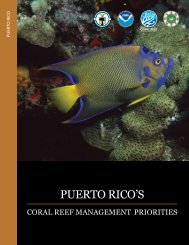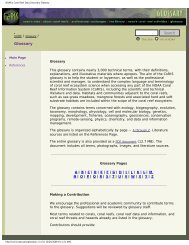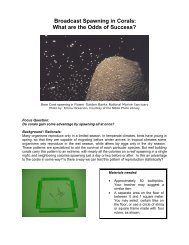Deep-Sea Coral Collection Protocols - NOAA's Coral Reef ...
Deep-Sea Coral Collection Protocols - NOAA's Coral Reef ...
Deep-Sea Coral Collection Protocols - NOAA's Coral Reef ...
- No tags were found...
Create successful ePaper yourself
Turn your PDF publications into a flip-book with our unique Google optimized e-Paper software.
Sclerites in octocoralsby Stephen D. CairnsAlthough branching morphology, corallum size, andcolor are valuable hints for the identification ofoctocorals, and are often the only charactersavailable for field identifications, the single mostimportant character in octocoral identification is themicroscopic calcareous sclerite (Bayer, 1956).Sclerites, also called “spicules”, are found in almostall 2800 octocoral species. They usually occur ingreat numbers in every colony, 10’s of thousandsnot being unusual in a modest sized colony. Even asmall fragment may contain thousands of sclerites.Each sclerite is a small piece of calcitic calciumcarbonate ranging in size from 20 um to 5 mm; theyare found in the polyps of the colony as well as inthe coenenchymal tissue between the polyps, eachgiving a small amount of support and structure to thetissue and polyps.Fig. 11a. An illustrated octocoral axis and polyps.Sclerites occur in many shapes and sizes, the first attempt at classifying them was the illustrated trilingualglossary edited by Bayer, Grasshoff, & Verseveldt (1983), which defined, synonymized, and illustrated57 sclerite types, some with the whimsical, yet descriptive, names of: caterpillar, crutch, finger-biscuit,hockey-stick, rooted head, wart club, capstan, and opera-glass. A species may have only one type andsize of sclerite or a variety, each type sclerite type occurring in a particular part of the colony and servinga slightly different function.It is easy to examine the sclerite types from a colony. One simply cuts a small piece containing a polypand branch from a larger colony, place it on a microscope glass slide, and add a drop of commonhousehold bleach. Wait a few minutes, or until the bubbles burst, place a cover slide over thepreparation (optional), and examine at x200 with a compound microscope, or as little as x50-100 witha dissecting microscope. SEM of sclerites done at x400-500 or higher magnifications is usually notnecessary for routine identifications but does provide excellent illustrations that can be used to describespecies.9Fig. 11b.
















